Updated: 07/05/2025
Aptly described by the naturalist Arthur-Miles Moss, the life of a caterpillar is a virtual struggle for safety from formidable predators, ruthless parasites, and fatal pathogens. To cope, caterpillars possess an array of anti-predator adaptations, or defenses, which aid them in the struggle. An individual caterpillar might employ camouflage, chemical defenses, hairs, spines, and aggressive behaviors to escape or repel its enemies. Despite the fact that these defenses constitute some of the classic examples of adaption, we still know very little about their effectiveness against predators in a natural community context.
The bold, gaudy colors of certain insects have arrested the eye of many a naturalist. Alfred Russel Wallace and Henry Bates, who collected butterflies in the Amazon, proposed an ingenious evolutionary explanation for the flashy appearances of many insects. They argued that conspicuous colors on insects are actually warning signals to would-be predators, such as birds, which advertise underlying chemical defenses. The stronger the signal, the clearer would be the message: “Don’t mess with me, I’m poisonous.” Thorough experimental confirmation of this idea, called aposematism, did not come until the second half of the 20th century.
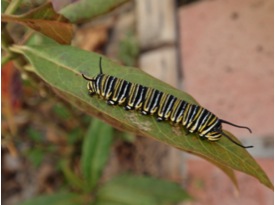
Figure 1. Aposematic caterpillar of the monarch butterfly on its milkweed host plant. Photo by Michael S. Singer.
The great Victorian naturalists likewise surmised that camouflage was another important defense of insects against bird predation. Observations of caterpillars, katydids, and walking sticks in their natural environments revealed a wondrous precision in the match between the insect’s appearance and the vegetation upon which it lived. Darwin’s and Wallace’s theory of natural selection was the best scientific explanation: only the best camouflaged individuals of each species would escape detection by predators.
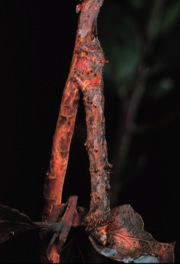
Figure 2. Camouflaged inchworm caterpillar on its host plant, manzanita, in southern Arizona. Photo by Michael S. Singer.
Over the last 50 years, many additional, important observations and experiments have reinforced these evolutionary theories of prey defense. But the vast majority of experimental studies used captive avian predators or artificial prey (such as dead or artificial insects) exposed to wild birds, leaving some question about the effectiveness of aposematism and camouflage in natural predator-prey interactions, which are notoriously difficult to observe directly in the wild. In the mean time, new techniques and technologies have emerged that allow researchers new modes of studying prey defenses in the wild.
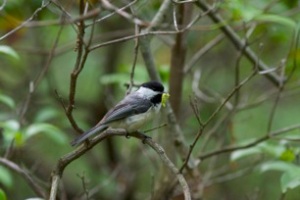
Figure 3. Black-capped chickadee with a captured caterpillar in one of the forest sites used to study bird predation of caterpillars in Connecticut. Photo by Christian Skorik.
Enter the new study by Lichter-Marck and colleagues, “The struggle for safety: effectiveness of caterpillar defenses against bird predation.” This study used a bird-exclusion field experiment set in the forests of Connecticut, USA to test evolutionary theories of prey defense in the context of a natural ecological community. Over four years, the research team surrounded hundreds of experimental tree branches with garden-variety bird-proof netting, matching each experimental branch with a control branch lacking netting. The netting was applied at the beginning of each growing season, and allowed caterpillars to come and go while preventing access to insectivorous birds. Three weeks later, the researchers returned to each branch and collected the caterpillars living on them. By experiment’s end, the caterpillar species with the largest proportional increase in numbers in experimental branches (protected from bird predation) relative to control branches (open to bird predation) were inferred to suffer the most bird predation. By measuring the defensive traits of each caterpillar species and correlating them with the inferred magnitude of bird predation, the researchers could determine which traits were most effective as defenses against bird predation.

Figure 4. Red maple branch covered with a bird-exclusion net, one of the experimental branches used in this study. Photo by Christian Skorik.
This unique methodological approach supported the main prediction of aposematism theory: among the 38 species of caterpillars that were numerous enough to analyze, those that possessed warning signals, such as bright coloration, received the most protection from birds. But the study revealed another, critical aspect of the warning strategy of defense: stereotypical resting location. The caterpillar species most protected from birds combined warning signals with highly stereotypical resting locations on the plant. That is, their appearance and their location together provided the warning signal to birds. This finding highlights the relatively neglected behavioral aspect of warning strategy of defense.
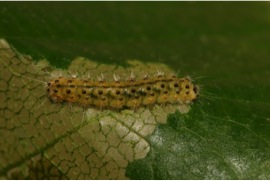
Figure 5. A warningly-signaled caterpillar species (Nola triquetrana) on its host plant, witch hazel, at one of the forest sites used in this study. Photo by Michael S. Singer.
Yet the majority of the 38 caterpillar species did not possess warning signals, instead employing camouflage as their primary defensive strategy. Because visual camouflage can result from several different tricks in appearance (disruptive patterns, countershading, etc.), the magnitude of camouflage can be difficult to measure. The researchers turned to an increasingly used method, the human proxy predator assay. In this assay, human participants were shown digital images of the caterpillar species resting on their host plants, and a computer program was designed to record how quickly each participant located each caterpillar with an accurate click of the mouse. The longer it took, on average, to find a caterpillar species, the greater the magnitude of camouflage was inferred.
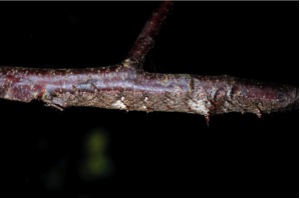
Figure 6. A camouflaged caterpillar species (Catocala ultronia) on its host plant, black cherry, at one of the forest sites used in this study. Photo by Michael S. Singer.
In support of evolutionary theory of prey defense, the study found that the caterpillar species with the greatest inferred magnitudes of camouflage received the most protection from birds. Once again, this part of the study revealed a behavioral twist. A caterpillar species’ frequency of behavioral responsiveness to attack, measured independently, worked against the effectiveness of camouflage. This finding suggests that effective camouflage requires not only an appearance that matches the prey’s background, but also behavioral maintenance of the cryptic posture in the face of physical disturbance.
The authors, through Michael S. Singer
